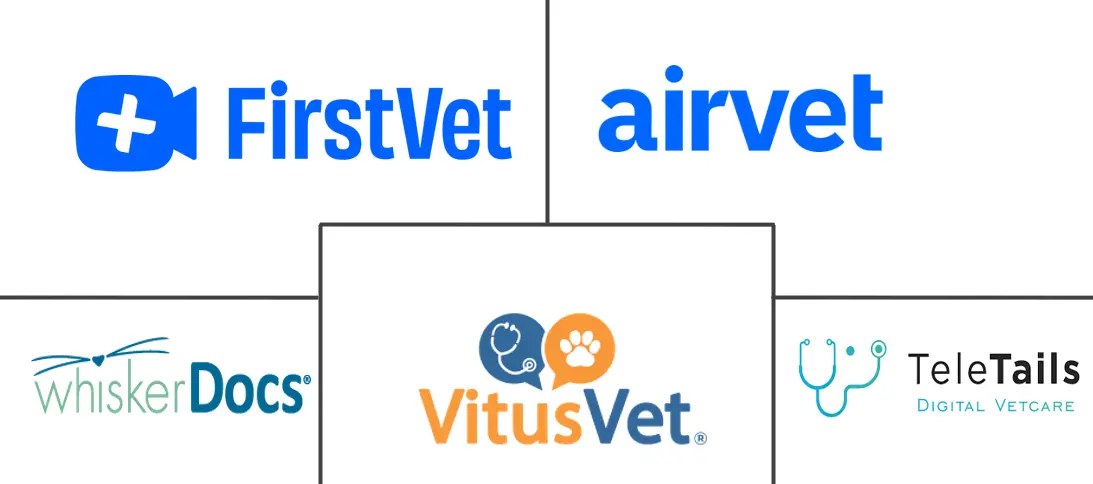Global Veterinary Telehealth Market Size and Share
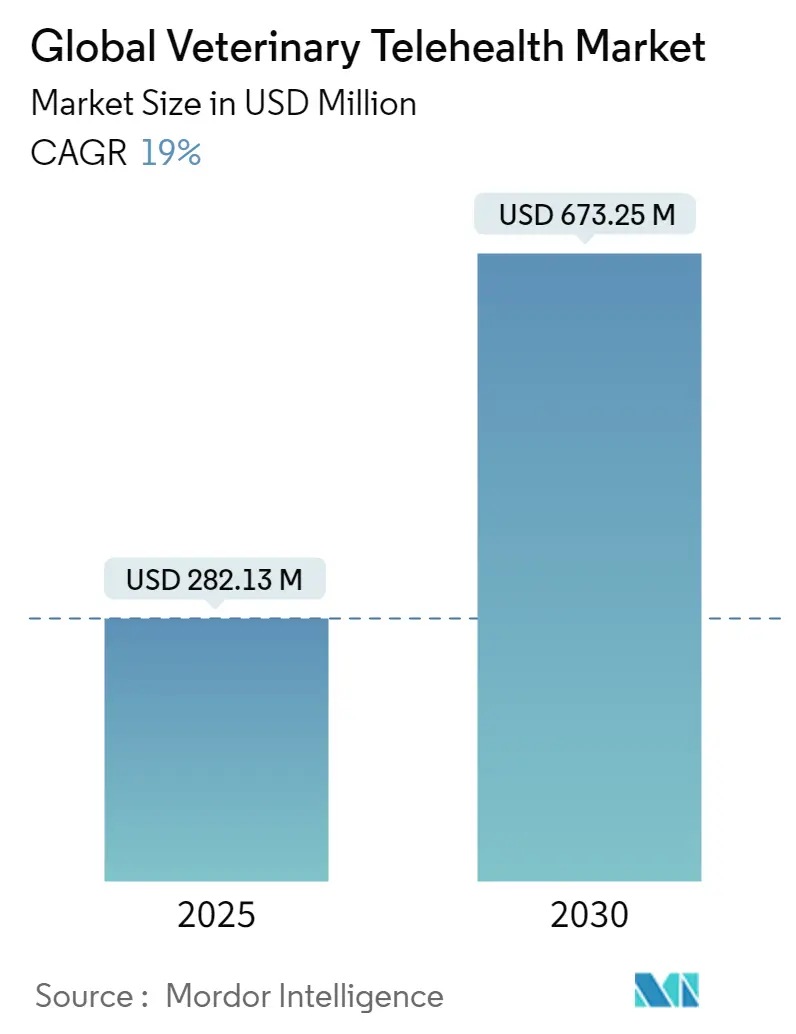
Global Veterinary Telehealth Market Analysis by Mordor Intelligence
The veterinary telehealth market size is estimated at USD 282.13 million in 2025 and is projected to reach USD 673.25 million by 2030, representing a forecast CAGR of 19%. Sustained double-digit expansion is unfolding as virtual care moves from experimental adoption to a standard extension of veterinary practice, and this shift is tightening the linkage between digital service availability and pet owner expectations. Converging forces—ranging from rapid improvements in broadband access to the ubiquity of smartphones—have widened the addressable base of connected pet households, steadily lowering the cost per consultation relative to in-clinic care. As a result, the veterinary telehealth industry is attracting fresh capital, with venture investors prioritising platforms that streamline practice workflows while safeguarding clinical oversight. An important but often overlooked inference is that growth is self-reinforcing: every incremental virtual visit generates data that, in turn, improves algorithmic triage accuracy, thereby boosting user confidence and spurring additional demand.
Looking forward, the veterinary telehealth market size is poised for outsized gains partly because regulatory barriers are receding faster than workforce constraints can be solved by conventional means. By 2030, more than one-third of companion-animal consultations in advanced economies are expected to start online, creating predictable utilisation spikes during evenings and weekends. Clinics that harness telehealth not only extend opening hours digitally but also convert follow-up calls—historically uncompensated—into billable interactions, improving practice margins. This revenue lift, even after platform fees, is encouraging independent veterinarians to join curated networks that advertise nationwide. A parallel dynamic is emerging in livestock, where early detection of disease via remote sensors materially reduces cull losses, suggesting that telehealth’s primary economic value may ultimately reside in prevention rather than treatment.
Key Report Takeaways
- Veterinary telehealth market size is projected to climb from USD 282.13 million in 2025 to USD 673.25 million by 2030, reflecting a 19 % CAGR that outpaces most other animal-health niches.
- Companion animals hold 67 % veterinary telehealth market share in 2024, and the segment’s momentum suggests that prevention-oriented wearable data streams will soon generate the lion’s share of recurring revenue.
- Regulatory liberalisation—spearheaded by measures such as Florida’s PETS Act—has shifted the conversation from “if” to “how fast” electronic VCPR models will scale nationwide.
- AI-enabled triage, already delivering 94 % accuracy on radiograph reads, is re-routing clinician time toward complex cases and effectively adding pseudo-capacity to a workforce that remains chronically understaffed.
- Asia Pacific is on course to post a 22.5 % CAGR through 2030, a trajectory powered by smartphone-native millennials and Gen Z pet owners who routinely choose video visits first.
Global Veterinary Telehealth Market Trends and Insights
Driver Impact Analysis
| Driver | (~)Percentage Point Impact on Market CAGR | Geographic Relevance | Impact Timeline |
|---|---|---|---|
| Increasing Pet Ownership | +4.2% | Global, with concentration in urban centers | Short term (≤2 yrs) |
| Increase in Veterinary Healthcare Spending | +3.8% | North America & Europe, emerging in APAC | Medium term (≈3-4 yrs) |
| Growing Prevalence of Zoonotic Diseases | +2.5% | Global, with higher impact in regions with intensive animal agriculture | Medium term (≈3-4 yrs) |
| Regulatory Flexibility Post-COVID | +3.5% | North America, with variable impact across states/provinces | Short term (≤2 yrs) |
| Rising Penetration of Pet Insurance | +2.8% | North America, Europe, emerging in urban APAC | Medium term (≈3-4 yrs) |
| AI-Enabled Triage Platforms | +3.2% | Global, with initial concentration in developed markets | Medium term (≈3-4 yrs) |
| Source: Mordor Intelligence | |||
Increasing Pet Ownership Across the Globe
Pet ownership has expanded to historic highs, with urban households in several emerging economies now approaching Western adoption levels. Younger cohorts demonstrate a strong correlation between digital tool usage and willingness to trial virtual care, meaning demographic renewal is hard-wiring telehealth into routine pet parenting. For service providers, this translates into a growing pipeline of first-time users who leapfrog phone advice and demand app-based video calls from day one. A noteworthy, data-driven inference is that sustained increases in pet adoption automatically diversify case-mix complexity, prompting platforms to build broader specialist panels earlier than originally planned.
Increase in Veterinary Healthcare Spending
Rising veterinary bills—compounded by corporate consolidation of physical clinics—continue to outpace general inflation, heightening cost sensitivity among pet owners. Insurers are responding by reimbursing virtual visits for non-emergency cases, thereby steering policyholders toward low-acuity digital channels that cost less than in-person appointments. This alignment of payer incentives with telehealth utilisation quietly accelerates repeat-visit frequency because owners face lower marginal costs, suggesting that telemedicine may actually grow total spend while reshaping its allocation. The industry therefore gains a de-risked revenue stream that scales with insurance penetration rather than discretionary out-of-pocket budgets.
Growing Prevalence of Zoonotic Diseases
The frequency of zoonotic outbreaks has amplified calls for continuous surveillance, and advanced telemonitoring platforms now combine behavioural analytics, temperature tracking and respiratory assessment to flag anomalies remotely. Peer-reviewed research confirms that such multi-parameter systems can detect fever with 92 % accuracy and identify behavioural deviations early in 78 % of monitored cases[1]Candice P. Chu, “ChatGPT in Veterinary Medicine: A Practical Guidance of Generative Artificial Intelligence in Clinics, Education, and Research,” Frontiers in Veterinary Science, frontiersin.org. A second-order effect is that public-health authorities gain anonymised data streams capable of revealing cross-species contagion patterns in near real-time. This public-private data fusion could position veterinary telehealth as a frontline bio-surveillance network—an outcome likely to attract policy support and research grants.
Regulatory Flexibility Post-COVID Boosting Telehealth Adoption
States and provinces are rewriting veterinary practice acts to legitimise electronic Veterinary-Client-Patient Relationships (eVCPR), effectively removing the main legal obstacle to first-visit video consultations. Florida’s 2024 statute, for example, grants clinicians the right to diagnose and prescribe online, signalling to other jurisdictions that consumer-centric legislation can coexist with safety safeguards. Regulatory liberalisation also introduces competitive pressure on lagging regions, as mobile-first providers advertise across borders, thereby highlighting service gaps to local constituents. A less visible consequence is that veterinary schools are refreshing curricula to include telemedicine competencies, ensuring that future graduates enter the workforce digitally native.
Rising Penetration of Pet Insurance Covering Virtual Care
North American enrolment passed 6 million insured pets in 2023, and nearly all major underwriters now cover video consultations for chronic condition management. Insurers leverage real-time device data to refine actuarial models, rewarding engaged owners with lower premiums for preventive behaviour. This feedback loop effectively monetises healthy routines, nudging policyholders to schedule brief virtual check-ins rather than wait for expensive emergencies. The resulting claims data set becomes a proprietary asset for carriers, making the underwriting of telehealth participation itself a differentiator in a crowded insurance market.
AI-Enabled Triage Platforms Enhancing Service Efficiency
Artificial intelligence is compressing diagnostic turnaround times: blood-sample interpretation that once took days is now completed in hours, while machine-vision algorithms reach 94 % accuracy on routine radiographs[2]Jordana Ostrov, “PetPace Health 2.0 Smart Collar Named 'IoT Wearable Device of the Year' in 9th Annual IoT Breakthrough,” PetPace, petpace.com. Such efficiencies allow veterinarians to redirect scarce clinical minutes toward high-value tasks, effectively stretching workforce capacity without compromising care quality. Importantly, regulatory bodies insist that final clinical judgment remains with licensed professionals, a stance that preserves trust even as AI handles the heavy lifting. The implication is that competitive advantage will accrue to platforms that weave AI insights seamlessly into practitioner dashboards rather than showcasing automation for its own sake.
Restraint Impact Analysis
| Restraint | (~) Percentage Impact on Market CAGR | Geographic Relevance | Impact Timeline |
|---|---|---|---|
| High Cost Associated with Services | -2.4% | Global, with higher impact in price-sensitive markets | Short term (≤2 yrs) |
| Limited Awareness in Developing Nations | -3.0% | APAC (excluding developed economies), Africa, parts of Latin America | Medium term (≈3-4 yrs) |
| Variability in Licensing Laws | -2.8% | Global, with particular impact in fragmented regulatory environments | Medium term (≈3-4 yrs) |
| Data Privacy & Cyber-Security Concerns | -2.2% | Global, with higher impact in regions with strict data protection laws | Medium term (≈3-4 yrs) |
| Source: Mordor Intelligence | |||
High Cost Associated with Services
Telehealth deployment involves encrypted video infrastructure, prescription compliance modules and staff training, all of which create upfront expense that smaller clinics struggle to amortise. These overheads often translate into higher consultation fees compared with a simple phone inquiry, diluting value perception among price-sensitive owners. Yet the fixed-cost nature of digital platforms means unit economics improve sharply as case volumes rise, giving scale players a structural cost edge. An industry inference is that cost barriers are temporary for those who achieve early network density but could prove fatal for under-subscribed regional apps.
Limited Awareness & Accessibility in Developing Nations
Bandwidth constraints, patchy smartphone ownership and low digital literacy limit telehealth uptake across swathes of Asia, Africa and Latin America. Cultural preferences for traditional animal health practices further suppress early demand, making outreach and education pivotal. Platforms that design for low-bandwidth chat or integrate voice-only triage can still penetrate these markets, demonstrating that product-market fit is partly a localisation challenge rather than a technology shortfall. The long-run prize is substantial: once connectivity improves, latent demand may surface rapidly due to the same leap-frogging dynamic witnessed in mobile banking.
Segment Analysis
Animal: Companion Animals Lead Digital Transformation
Companion animals hold the dominant veterinary telehealth market share at 67% of 2024 revenue, with dogs and cats forming the bulk of virtual consultations. The segment’s forecast CAGR exceeds 20%, a pace underpinned by strong emotional bonds that translate into high willingness to invest in convenient care. Wearable devices such as the AI-powered PetPace 2.0 collar deliver continuous vitals tracking, giving owners actionable insights and funneling a steady stream of data to clinicians. One clear inference is that each device sold creates a recurring telemetry data feed, effectively turning hardware revenue into long-tail service subscriptions.
A secondary companion-animal development is the rise of behaviour-centric teleconsults, where owners seek guidance on anxiety, diet or post-operative recovery without the stress of clinic visits. Behavioural video assessments often uncover early warning signs of chronic disease, highlighting telehealth’s preventive capabilities. Meanwhile, equine owners—historically underserved digitally—are adopting remote lameness evaluations, broadening the companion-animal definition to include higher-value patients. This diversification reduces platform dependence on dog-centric traffic and stabilises revenue across species cycles.
Livestock veterinary telehealth market size is smaller today but forecast to expand at a high-teens CAGR through 2030 as precision farming tools mature. IoT ear tags and barn-level environmental sensors now feed cloud dashboards that flag deviations in feed intake or rumination patterns, enabling earlier veterinary intervention. Peer-reviewed studies show that such systems can predict mastitis in dairy herds days before clinical signs appear, cutting antibiotic usage and improving milk yield [3]Jayant Pawar, “Transforming Cattle Farming With Artificial Intelligence: Innovations, Applications, and Implications for Precision Livestock Management and Sustainable Agriculture Practices,” Revista Electronica De Veterinaria, veterinaria.org. The underlying inference is that telehealth converts health management from episodic treatment to continuous optimisation, directly boosting farm profitability.
Economic logic is compelling: even fractional reductions in morbidity translate into substantial savings at commercial scale, shifting telehealth from discretionary spend to operational necessity. Poultry operators, for example, deploy thermal-imaging cameras linked to AI that identify flock-level respiratory distress within hours, allowing rapid ventilation adjustments. Such capabilities illustrate that livestock telehealth is less about one-to-one video calls and more about fleet-scale analytics, hinting at future convergence with agri-tech platforms.
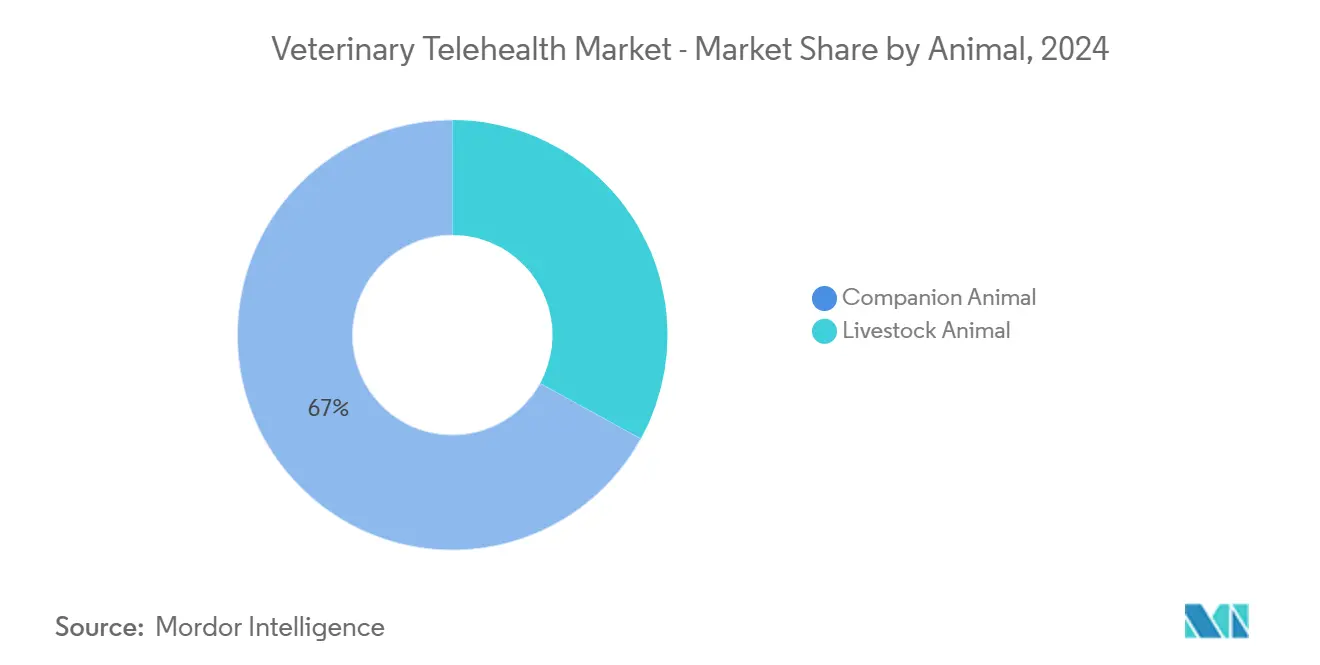
Note: Segment shares of all individual segments available upon report purchase
Service Type: Telemedicine Dominates While Telemonitoring Accelerates
Telemedicine accounts for 58% veterinary telehealth market share today, reflecting its straightforward translation of in-person consultations to video format. Primary-care clinics lean on telemedicine for triage and prescription refills, freeing scarce appointment slots for complex cases. An insightful development is the surge in after-hours virtual urgent care, which captures revenue that previously leaked to emergency hospitals, thereby cementing telemedicine as margin-accretive rather than cannibalistic.
Telemonitoring, though representing a smaller slice of current revenue, is forecast to grow at nearly 20% CAGR through 2030 as smart collars and implantable sensors proliferate. The newly crowned “IoT Wearable Device of the Year” PetPace Health 2.0 exemplifies the category’s momentum. Continuous data flows allow veterinarians to transition from reactive to proactive care, smoothing clinic workloads and reducing peak-time bottlenecks. The strategic implication is that telemonitoring revenue is recurring and data-rich, positioning it as the sector’s future profit engine.
Delivery Mode: Web/Cloud Platforms Evolve as Mobile Apps Gain Momentum
Web-based portals command a 62% share of veterinary telehealth market size because they integrate seamlessly with existing practice-management software, enabling clinicians to toggle between appointment calendars and virtual exam rooms without context switching. Cloud hosting simplifies compliance with data-retention regulations, an often underestimated factor in clinical adoption. However, user analytics show that appointment booking via smartphone now outnumbers desktop in most age cohorts, driving a 19% CAGR forecast for mobile-app revenue.
The mobile pivot is reshaping feature roadmaps: platforms now embed medication reminders, e-commerce links and AI symptom checkers directly into apps, thereby anchoring daily user engagement. A practical inference is that push-notification architecture gives mobile-first providers a low-cost channel for proactive outreach, strengthening brand stickiness versus web-only rivals. In rural regions with limited broadband, low-bandwidth chat remains vital, demonstrating that a multi-modal approach is necessary for truly inclusive service coverage.
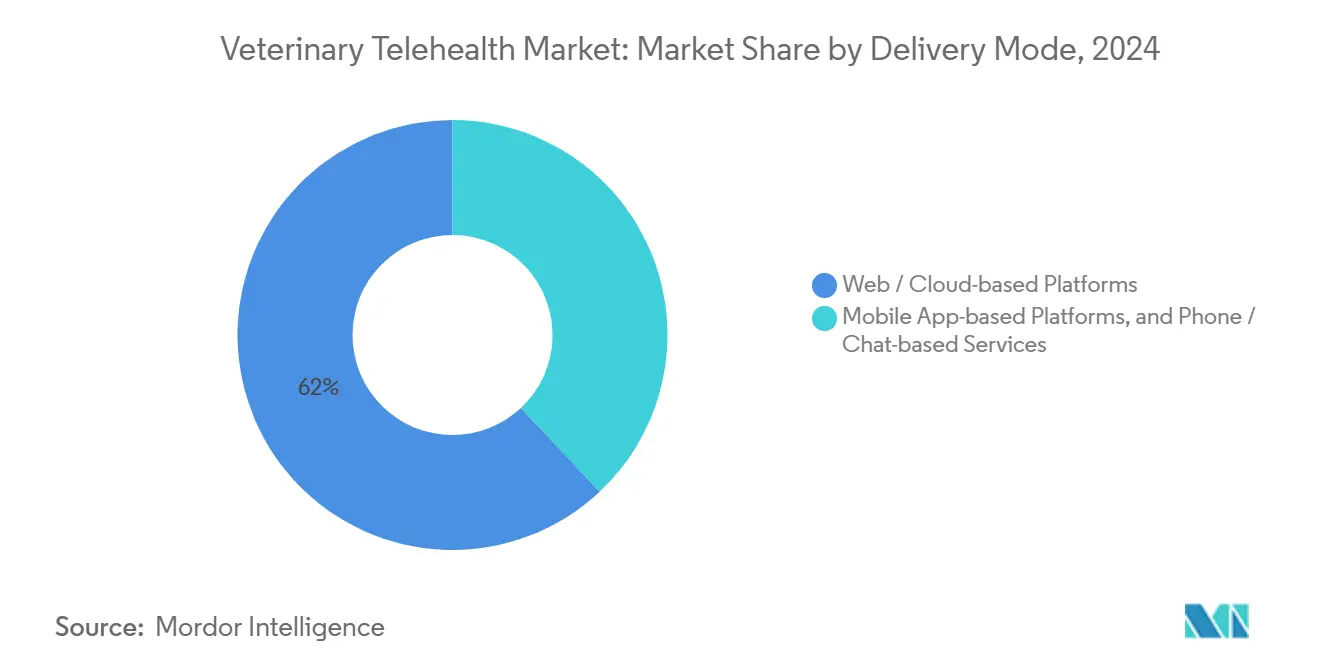
Note: Segment shares of all individual segments available upon report purchase
End User: Clinics Lead While Direct-to-Consumer Surges
Veterinary clinics and hospitals retain 55% of veterinary telehealth market share in 2024, leveraging digital consultations to expand geographic reach without adding physical exam rooms. Platform dashboards that integrate lab results, imaging and payment capture enable a unified client experience, encouraging repeat visits. A fresh inference is that clinics exploiting telehealth for post-surgical check-ins report faster discharge times, indirectly boosting cage turnover and revenue per square foot.
Direct-to-consumer usage by pet owners is growing fastest, with projected 21% CAGR through 2030 as convenience expectations mirror human telemedicine habits. Survey data indicate that two-thirds of owners are open to video first opinions, suggesting latent demand still outstrips supply. Importantly, as consumer apps gain traction, the balance of power shifts: clinics that decline to participate risk relegation to complex-case specialists, ceding routine care to always-on virtual competitors. Livestock farm managers and independent veterinarians round out the end-user mix, benefiting from remote herd management tools and flexible work arrangements respectively.
Geography Analysis
North America commands roughly 47% of 2024 veterinary telehealth market share thanks to high pet insurance coverage, advanced broadband infrastructure and progressive regulatory momentum. U.S. states such as Florida have enacted legislation permitting eVCPR initiation, effectively nationalising competition for digital platforms. Canada trails but is closing the gap as provincial regulators study U.S. outcomes, while Mexico’s nascent pet-insurance sector creates white-space for low-cost teletriage offerings. A notable inference is that cross-border Spanish-English bilingual apps may emerge as a regional differentiator, capturing North America’s under-served Hispanic pet owner segment.
Asia Pacific is the fastest-growing geography with a projected 22.5% CAGR from 2025 to 2030, catalysed by rapid pet humanisation and swelling middle-class incomes. China’s millennial and Gen Z owners already represent half of all pet households, making mobile-first design and social-commerce integration business-critical. In India, urban pet ownership is forecast to climb from one-quarter to one-third of households within the next few years, suggesting a steep virtual-care adoption curve once awareness campaigns mature. The key inference is that, unlike North America, many Asia-Pacific markets will skip desktop portals entirely, embedding veterinary telehealth industry growth directly into super-apps.
Europe exhibits heterogeneous adoption: the United Kingdom leads with established players leveraging GDPR-compliant data architectures, whereas parts of Southern and Eastern Europe remain early-stage due to fragmented veterinary practice structures. Strong privacy regimes elevate cybersecurity from table-stakes to market-entry barrier, favouring vendors that can certify end-to-end encryption and optional local data residency. An intriguing observation is that telehealth consultations in languages such as German and French face limited competition, presenting local-language platforms with defensible niches.
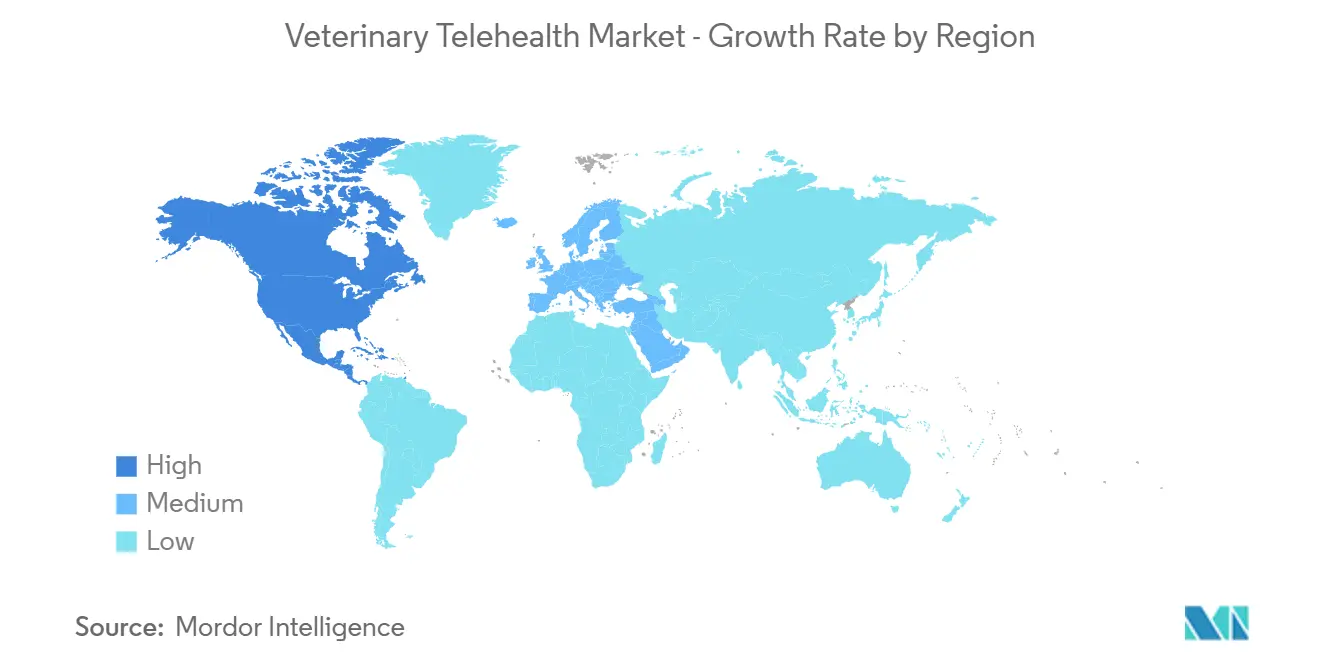
Competitive Landscape
First-generation pure-play platforms, traditional clinic chains and technology conglomerates now vie for veterinary telehealth market share, producing a dynamic yet fragmented competitive landscape. Specialist collaborations are increasingly decisive: device manufacturers integrate with software platforms to create one-stop ecosystems spanning triage, monitoring and pharmacy fulfilment. This ecosystem approach generates network effects—more devices feed more data, which improves algorithms that attract more users—making early integration partners attractive acquisition targets.
Consolidation is accelerating. Private-equity-backed transactions such as the landmark Covetrus buy-out underscore the sector’s perceived resilience and cross-selling potential. Mergers like The Vets with BetterVet combine at-home services with telemedicine, signalling that omnichannel veterinary care is rapidly becoming the competitive baseline. A strategic inference is that regional dominance will hinge not only on funding but also on nuanced regulatory navigation; platforms capable of scaling legal compliance state-by-state or country-by-country gain a first-mover moat.
Despite consolidation, white-space remains abundant. Exotic-animal telehealth, livestock-specific analytics and integrated pharmacy-delivery models remain under-penetrated. Firms that credibly address data-sovereignty concerns and build culturally adapted UX could capture outsized loyalty in markets where incumbents rely on English-only interfaces. Ultimately, differentiation will pivot on clinical outcome evidence: platforms that publish peer-reviewed validation of algorithm accuracy or health-economic savings will command premium valuation multiples.
Global Veterinary Telehealth Industry Leaders
-
Airvet
-
TeleTails
-
FirstVet
-
VitusVet
-
Whiskers Worldwide, LLC
- *Disclaimer: Major Players sorted in no particular order
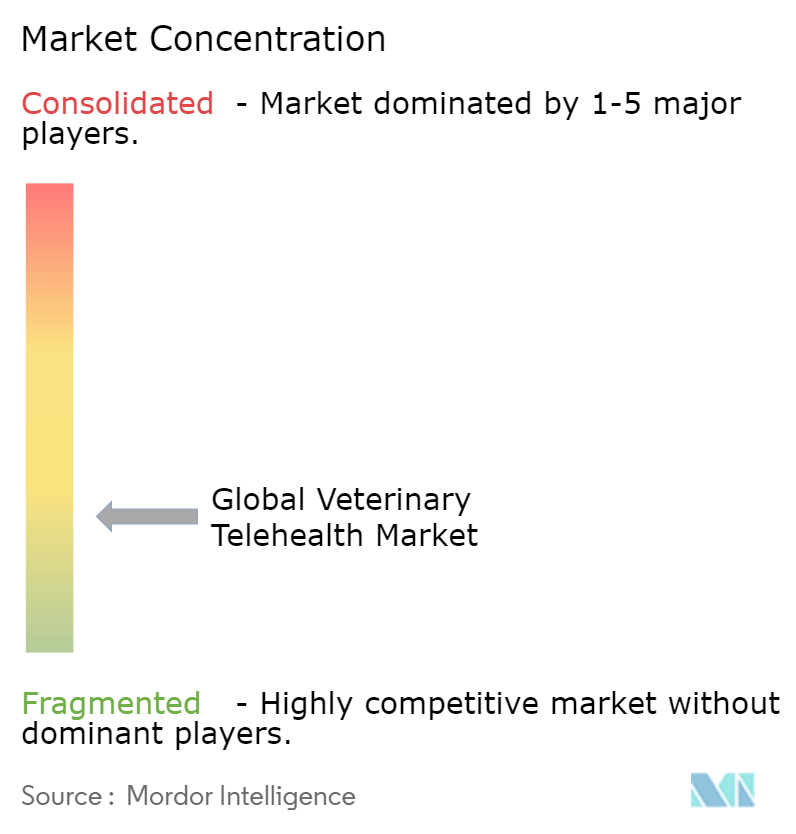
Recent Industry Developments
- January 2025: PetPace Health 2.0 Smart Collar received “IoT Wearable Device of the Year,” spotlighting continuous vital-sign capture as a mainstream feature of companion-animal care. The accolade validates the commercial momentum of data-stream-driven telemonitoring.
- October 2024: Mella Pet Care partnered with a leading telemedicine provider to embed its connected thermometers into virtual consultations. This union showcases how hardware data enriches video assessments, reducing subjective symptom descriptions.
- June 2024: FirstVet closed a USD 21.4 million Series C funding round, its sixth to date, enabling expansion of its multilingual European telehealth platform. The new capital earmarks resources for AI-based triage tools and deeper insurer integrations.
Research Methodology Framework and Report Scope
Market Definitions and Key Coverage
Our study defines the veterinary telehealth market as all fee-based real-time or asynchronous remote clinical interactions, video, voice, text, or app, between licensed veterinarians and animal owners or caretakers, delivered through cloud, web, or phone-enabled platforms. The valuation captures gross platform service revenues plus professional service fees for companion and livestock animals worldwide, amounting to USD 282.13 million in 2025.
Scope Exclusions: one-off software license sales, diagnostic hardware, generic practice management systems, and non-clinical pet wellness apps remain outside the scope.
Segmentation Overview
- By Animal
- Companion Animal
- Cats
- Dogs
- Horses
- Other Pet Animals
- Livestock Animal
- Cattle
- Sheep
- Poultry
- Other Livestock
- Companion Animal
- By Service Type
- Telemedicine
- Teleconsulting
- Telemonitoring
- Other Service Types
- By Delivery Mode
- Web / Cloud-based Platforms
- Mobile App-based Platforms
- Phone / Chat-based Services
- By End User
- Veterinary Clinics & Hospitals
- Independent Veterinarians
- Telehealth Platform Providers
- Pet Owners
- Livestock Farm Owners
- By Geography
- North America
- United States
- Canada
- Mexico
- Europe
- Germany
- United Kingdom
- France
- Italy
- Spain
- Rest of Europe
- Asia Pacific
- China
- Japan
- India
- Australia
- South Korea
- Rest of Asia Pacific
- Rest of the World
- North America
Detailed Research Methodology and Data Validation
Primary Research
Interviews and pulse surveys with platform founders, mixed animal clinicians across North America, Europe, and Asia-Pacific, and national regulatory advisors validated utilization rates, average consult pricing, and region-specific Veterinary-Client-Patient-Relationship (VCPR) rules, enabling us to adjust desk-derived assumptions with real-world behavior.
Desk Research
Our analysts first mapped publicly available veterinary service utilization, pet population, and livestock herd data from sources such as the World Organisation for Animal Health, USDA-APHIS, Eurostat livestock statistics, and national veterinary associations. Trade databases (Volza import shipment codes for handheld imaging devices) helped approximate hardware adoption that correlates with teleconsult volume. Annual reports and 10-Ks from listed telehealth platform operators complemented trend signals, while Dow Jones Factiva screened 4,000+ news items for funding and regulatory moves. D&B Hoovers supplied baseline financials for private platforms. The sources cited are illustrative; numerous additional publications were reviewed to cross-verify facts.
Market-Sizing & Forecasting
A top-down reconstruction that starts with companion and production animal counts, typical annual consult rates, and telehealth penetration produced the first set of totals, which are then corroborated through selective bottom-up checks such as sampled average selling price multiplied by platform visit volumes shared confidentially by practitioners. Key fingerprints in the model include urban pet ownership growth, smartphone penetration, regulatory flexibilities post-COVID, average consult price progression, and venture funding inflow to telehealth platforms. Multivariate regression links these variables to historic revenue to forecast through 2030; scenario analysis adjusts for pending VCPR reforms.
Data Validation & Update Cycle
Outputs move through variance and anomaly checks, senior analyst review, and a second pass against independent indicators before sign-off. Reports refresh yearly, with interim re-contacts triggered by material events such as major regulatory changes or large platform funding rounds.
Why Our Veterinary Telehealth Baseline Commands Reliability
Published figures differ because each publisher frames the market in its own way and updates at different cadences. Service scope, animal cohorts, pricing capture, and refresh timing are the usual fault lines.
Key Gap Drivers include inclusion of hardware sales within service revenues, counting consumer wellness apps, or applying straight-line CAGR to dated baselines without VCPR scenario testing, which may inflate or dampen values.
Benchmark comparison
| Market Size | Anonymized source | Primary gap driver |
|---|---|---|
| USD 282.13 M (2025) | Mordor Intelligence | - |
| USD 365.20 M (2025) | Global Consultancy A | Adds telemedicine software licenses and bundled e-pharmacy revenue |
| USD 303.45 M (2024) | Regional Consultancy B | Uses 2024 base and extrapolates 20.8 % CAGR without separate livestock filter |
| USD 400.00 M (2024) | Industry Database C | Blends remote monitoring hardware with platform fees and applies revenue share mark-ups |
The comparison shows that once non-clinical or hardware streams are stripped out and penetration rates are stress tested through primary interviews, Mordor's disciplined approach delivers a balanced, reproducible baseline that decision-makers can trust.
Key Questions Answered in the Report
How big is the Global Veterinary Telehealth Market?
The Global Veterinary Telehealth Market size is expected to reach USD 282.13 million in 2025 and grow at a CAGR of 19% to reach USD 673.25 million by 2030.
Which animals benefit most from telehealth?
Companion animals, particularly dogs and cats, currently account for the majority of virtual visits because owners are highly motivated to seek convenient care and are comfortable using smartphones.
Who are the key players in Global Veterinary Telehealth Market?
Airvet, TeleTails, FirstVet, VitusVet and Whiskers Worldwide, LLC are the major companies operating in the Global Veterinary Telehealth Market.
Which is the fastest growing region in Global Veterinary Telehealth Market?
Asia-Pacific is estimated to grow at the highest CAGR over the forecast period (2025-2030).
Which region has the biggest share in Global Veterinary Telehealth Market?
In 2025, the North America accounts for the largest market share in Global Veterinary Telehealth Market.
Page last updated on:
